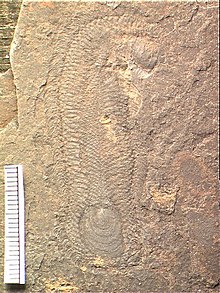Sirius Passet Fauna Community
The Sirius Passet Faunal Community is a Lower Cambrian conservation deposit on Pearyland in the far north of Greenland . Most of the fossils found there are soft-body organisms that were deposited in the mud of deep water near a shallow carbonate bank.
The Sirius Passet Fauna Community was named after the Sirius patrol that operates in northern Greenland. The fossil deposit is located on the east coast of the JP Koch Fjord in the lower section of the Buen Formation . It was discovered in 1984 by A. Higgins, an employee of Grønlands Geologiske Undersøgelse . A preliminary report was published in 1987 by Simon Conway Morris et al. a. released. Subsequently, in 1989, 1991 and 1994 three further expeditions, led by JS Peel and Simon Conway Morris, returned to the site and brought together a collection of around 10,000 fossils.
Stratigraphy and general geological framework
The 325-meter-thick Sub-Cambrian Buen Formation overlaps the light gray dolomites of the neoproterozoic Portfjeld Formation with abnormal contact (faults) . They are followed by the Brønlund Fjord Group . The Buen Formation is one of the shelf sediments of the southern Franklin Basin (northern Greenland and the Arctic Islands of Canada). In its lower section it is mainly dominated by sandy facies , the upper section consists of gray-green clay and silt stones . To the north, the Buen Formation gradually merges into the deeper continental slope facies of the simultaneous group of polar corridors (700 meters thick deep-water deposits). During the Ellesmerian orogeny , the formation suffered a weak metamorphosis and was overprinted with green slate facies.
The conservation deposit is located in dark gray to black claystones in the lowest section, in the transition area between the Buen Formation and the polar corridor group.
The occurrence of the trilobite Buenellus higginsi allows the correlation of the deposit with the laurent trilobite zone Nevadella ; the latter is now equated with the 2nd series, 3rd stage of the Cambrian (521 - 514 million years BP ).
fauna
The Sirius Passet faunal community was inevitably associated with the Burgess slate , although it is believed to be ten to fifteen million years older and was suggested by Martin et al. a. (2000) is dated to 518 to 505 million years BP. This brings it much closer in time to the Chengjiang faunal community .
The fauna community has not yet been fully described scientifically, but it is becoming apparent that it consists of a relatively limited number of arthropods, sponges and rare representatives of other groups. It also contains three highly problematic taxa - Halkieria , Kerygmachela and Pambdelurion - which play an important role in the discussion about the origin of today's animal phyla .
At the beginning of 2008, Simon Conway Morris and colleagues published a scientific paper on the Sirius Passet faunal community in the journal Acta Palaeontologica Polonica , in which they describe many bristles from the tribe of annelids . You state: "The tribal allocation of the Phragmochaeta is still very vague, but could be of a basic nature". It should be noted here that poly-bristles are quite important in the fauna of the Burgess slate, but are practically unknown in the other Lower and Central Cambrian fossil deposits. This single finding expands our understanding of this group of animals considerably. Unfortunately, the specimens described so far are relatively poor in morphological characteristics.
Nearly 6000 fossil-bearing rock fragments, which had been selected between 1985 and 2006, were used for their work. In addition, other fossil-bearing sites are known, but they have not yet been investigated in detail.
Fauna sorted by tribes
- Phylum Annelida (annelids)
- Phylum Arthropoda (arthropod)
- Aaveqaspis inesoni
- Buenaspis forteyi
- Isoxys volucris
- Kiisortoqia soperi
- Pauloterminus spinodorsalis - a crustacean
- Siriocaris trollae
- Phylum Arthropoda - class Trilobita
- Tribe Lobopodia (Lobopods)
- Hadranax augustus
- Kerygmachela kierkegaardi - a dinocarid
- Pambdelurion whittingtoni - a dinocarid
- Tamisiocaris borealis
- Trunk of uncertain assignment
literature
- Martin, MW; Grazhdankin, DV; Bowring, SA; Evans, DAD; Fedonkin, MA ; Kirschvink, JL: Age of Neoproterozoic Bilaterian Body and Trace Fossils, White Sea, Russia: Implications for Metazoan Evolution . In: Science . 288, 2000, pp. 841-845. doi : 10.1126 / science.288.5467.841 . PMID 10797002 .
- Simon Conway Morris and John S. Peel : The earliest annelids: Lower Cambrian polychaetes from the Sirius Passet deposit, Peary Land, North Greenland . In: Acta Palaeontologica Polonica . 53, 2008, pp. 137-148.
Web links
- Sirius Passet deposits at palaeos.com
Individual evidence
- ↑ Paul Selden and John Nudds: Window on Evolution - Famous Fossil Findings of the World (translated by Jens Seeling), Elsevier Spektrum Akademischer Verlag, Munich 2007, ISBN 978-3-8274-1771-8 , p. 27
- ^ S. Conway Morris and JS Peel: The earliest annelids: Lower Cambrian polychaetes from the Sirius Passet deposit, Peary Land, North Greenland. Acta Palaeontologica Polonica, Vol. 53, No. 1, pp. 137–148, 2008 (pdf; 2.14 MB)
- ↑ Simon Conway Morris & John S. Peel (2008). The earliest annelids: Lower Cambrian polychaetes from the Sirius Passet deposit, Peary Land, North Greenland (PDF; 2.2 MB)
Coordinates: 82 ° 47 ′ 36 " N , 42 ° 14 ′ 42" W.

